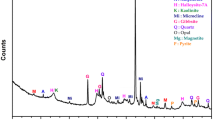Abstract
Bulk (lump) densities of 31 kaolins were measured on the clay in the natural or raw state after drying at 100°C and after firing to 1510°C (2700°F). The kaolins were selected from such diverse origins as surface-weathered and sedimentary accumulations, hydrothermally altered bodies and flintclay deposits. The sedimentary group ranged in density from 0·82 to 1·85 in the dried raw clay, and 1·93 to 2·63 when fired. The hydrothermally altered clays ranged from 1·83 to 2·50 in the dried raw state, and 2·02 to 2·66 when fired. Flint clays ranged from 2·20 to 2·60 in the dried raw state (a “toasted clay” from Russia, 1.75), and 1·99 to 2·70 when fired. The effect of the genetic process on bulk density values is discussed and related.
Similar content being viewed by others
References
Chukhrov, F. V. (1970) Analogues of flint clays in Soviet literature: Clays and Clay Minerals 18, 1–5.
Hanson, R. F. and Keller, W. D. (1966) Genesis of refractory clay near Guanajuato, Mexico: Proc, 14th Nat. Conf. Clays and Clay Minerals, pp. 259–267.
Hanson, R. F. and Keller, W. D. (1971) Flint clay by hydrothermal alteration of sedimentary rock in Mexico: Clays and Clav Minerals 19, 115–119.
Keller, W. D., Westcott, J. F. and Bledsoe, A. O. (1954) The origin of Missouri fire clays; Proc. 2nd Conf. Clays and Clay Minerals, NAS-NRC Pub. 327, pp. 7–46.
Keller, W. D., McGrain, Preston, Reesman, A. L. and Saum, N. M. (1966) Observations on the origin of endellite in Kentucky, and their extension to “Indianaite”: Proc. 13th Nat. Conf. Clays and Clay Minerals, pp. 107–120.
Keller, W. D. (1968) Flint clay and a flint-clay facies: Clays and Clay Minerals 16, 113–128.
Keller, W. D. and Hanson, R. F. (1968) Hydrothermal alteration of a rhyolite flow breccia near San Luis Potosi, Mexico, to refractory kaolin: Clays and Clay Minerals 16, 223–229.
Keller, W. D. and Hanson, R. F. (1969) Hydrothermal argillation of volcanic pipes in limestone in Mexico: Clays and Clay Minerals 17, 9–12.
Keller, W. D. and Hanson, R. F. (1975) Dissimilar fabrics by scan electron microscopy of sedimentary vs hydro-thermal clays in Mexico: Clays and Clay Minerals 23, 201–204.
Klinefelter, T. A., O’Meara, R. G., Truesdell, G. C. and Gottlieb, S. (1943) Hard and soft kaolins of Georgia: U.S. Bur. Mines., Rpt. Invest. No. 3682, 20 pp.
Patterson, S. H. and Hostermann, J. W. (1962) Geology and refractory clay deposits of the Haldeman and Wrigley Quadrangles, Kentucky: U.S. Geol. Surv. Bull. 1122F, 113 pp.
Author information
Authors and Affiliations
Rights and permissions
About this article
Cite this article
Baumann, D., Keller, W.D. Bulk Densities of Selected Dried Natural and Fired Kaolin Clays. Clays Clay Miner. 23, 424–427 (1975). https://doi.org/10.1346/CCMN.1975.0230602
Received:
Accepted:
Published:
Issue Date:
DOI: https://doi.org/10.1346/CCMN.1975.0230602




